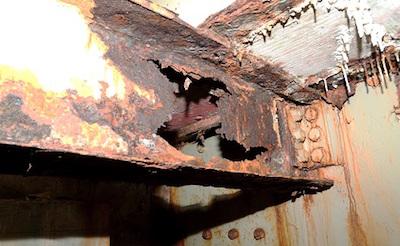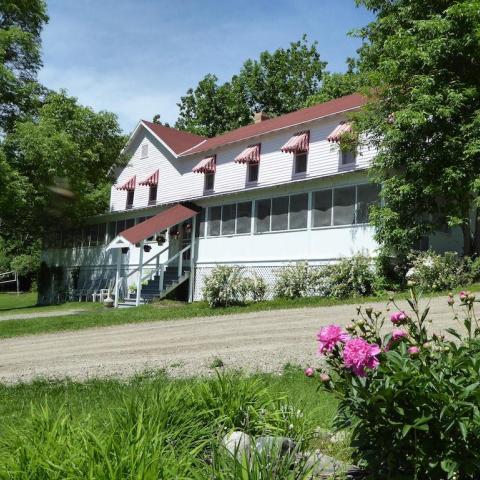Having already announced earlier this year that the maintenance backlog across the National Park System is closing in on $12 billion, the National Park Service is now highlighting the structural problems with the Arlington Memorial Bridge in Washington, D.C., in a bid to raise congressional awareness of the problems.
The bridge, the symbolic entry to Washington, D.C., and its iconic monument core, "needs a major overhaul or it will have to be closed in 2021," the Park Service said last week in a release.

Erosion eating away a beam under the Arlington Memorial Bridge/NPS
An inspection by the Federal Highway Administration last month found that deterioration of the bridge has accelerated since a 2015 inspection. Repair and renovation costs are estimated at $250 million. The National Park Service has spent nearly $10 million on temporary repairs since 2010 with another $5 million emergency repair due to start late this year.
“Memorial Bridge is a significant example of the immediate challenges we are facing across the National Park System to repair and maintain roads, bridges, and other essential transportation systems that not only connect people to the parks, but that also can be part of people’s daily commutes,” said Park Service Director Jonathan B. Jarvis.
Nationwide, the National Park Service has $11.9 billion of deferred maintenance projects – maintenance that has been put off for one year or more because of a lack of funds. Of this total, slightly more than half is deferred transportation maintenance.
The NPS transportation portfolio includes about 5,500 miles of paved roads, the equivalent of 970 miles of paved parking areas, more than 4,500 miles of unpaved roads, and more than 1,400 bridges. In addition to the Arlington Memorial Bridge, the National Park Service is responsible for parkways including the Baltimore Washington Parkway and George Washington Memorial Parkway in the Washington, D.C., metropolitan area. Across the country, the NPS also manages the Blue Ridge Parkway in North Carolina and Virginia; Natchez Trace Parkway in Alabama, Mississippi, and Tennessee; and Colonial Parkway in Virginia. Important NPS road systems that allow visitors to access our national parks include the Grand Loop at Yellowstone National Park, the Going to the Sun Road at Glacier National Park, and the Arterial Loop at Delaware Water Gap National Recreation Area. Each of those parkways or loop roads have repair needs that, taken together, exceed a billion dollars.
The National Park Service received some transportation funding increases as a result of the federal highway bill signed into law in December 2015. The NPS transportation allocation rose from $240 million in 2015 to $268 million in 2016 and will increase by $8 million per year over the next four years to $300 million per year by 2020.
The new federal highway funding law also included new programs that could help support large projects like Memorial Bridge, but those programs require non-federal matching dollars.
“The National Park Service will need the support of partnerships with other federal, state, and local entities, to compete successfully for funds available from the Department of Transportation,” Director Jarvis said. “We are pursuing every funding possibility to find a path forward to repair Memorial Bridge.”

A stringer is being eaten away by rust on the Arlington Memorial Bridge/NPS
The NPS has created successful coalitions and partnerships to accomplish other major transportation projects. For example, the NPS is partnering with the State of Florida on the $144 million Tamiami Trail bridge project to restore more natural water flows to Everglades National Park, and has leveraged other federal Department of Transportation funding for that project.
“This is the centennial year of the National Park Service, and the record breaking visitation we have seen over the past two years clearly demonstrate that the American people love and care about their national parks,” the director said. “It’s crucial that we find a solution to care for the iconic places in our care, so that the places that inspire us are here to do the same for generations to come.”




 Support Essential Coverage of Essential Places
Support Essential Coverage of Essential Places







Comments
So what? 99% of the people using the bridge neither orginate nor terminate their trip from those too points. Most probably don't even know the entered NPS land. But you bring up a good point. Why are the GW & BW parkways the responsibility of the NPS?
So the citizens of Tucson can get the NPS to maintain Speedway Blvd because it joins both sections of Saguaro NP?
Putting roads and bridges under NPS budgets does have the virtue of masking the scale of spending on DC however
It was Congress that declared the Bridge to be NPS property. Ask them.
Here's an idea. Coat it with gold leaf, hang a big flashing sign that says TRUMP above it and let The Donald sell it to Russia or China or whoever he can get to buy the brand.
But then they'd probably set up toll booths at both ends.
Y'just can't win.
I don't care who's responsible. It is stupid and is emblematic of the NPS being stretched beyond its mission and means.
A diligent and comprehensive reading o the Arlington Memorial Bridge wikipedia entry explains in detail, step by polital stepo, from 1886 through the present the detailed history of how and why Arlington Memorial Bridge came to be as it is today.
Like ir or not, the understanding is there to be had.